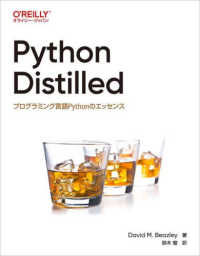Full Description
Far from being a context in which communication occurs, culture is the very basis of communication.Communication as Culture explains that whether people talk with family members or someone from another country, they are never anything more or less than enculturated people who abide by the limits of their language, values and ideals. People talk about certain things and view others in certain ways. Everything a person does and says reinforces or shows opposition to culture.
This means that, rather than being the source, the self is the product and manifestation of all things cultural. The purpose of this textbook, then, is to offer an alternative approach to the study of human communication.
Contents
Preface and Acknowledgments
About the Authors
Chapter 1 Introduction to Communication as Culture
Learning Objectives
Introduction
The Electronic Communication Revolution
Purpose of the Text
Culture Defined
The Study of Culture
Ethnomethodology
Reading: A Conception of and Experiments with "Trust" as a Condition of Concerted Stable Actions by Harold Garfinkel
Summary
Chapter 2 Definition of Communication
Learning Objectives
Poem: Blind Men and the Elephant by John Godfrey Saxe
Introduction
Communication Defined
A Side Note on Theory
Theory Defined
Approaches to Theory Construction
Metatheories
Ontology
Epistemology
Axiology
Summary
Reading: Defining Communication by Donald B. Egolf
Chapter 3 A Short History of the Study of Communication
Learning Objectives
Introduction
450 B.C.E. to the 1900s
The 1920s to the 1940s
The 1940s to the 1950s
A Side Note on Models of Communication
The 1950s to the 1970s
The 1970s to the Present
Organizational/Institutional Communication
Small Group Communication
Interpersonal Communication
Intrapersonal Communication
A Side Note on the National Communication Association
Summary
Chapter 4 Perception and Reality
Learning Objectives
Introduction
Perception Defined
Communication and Reality
Multiple Realities
The Perceptual Process
Summary
Reading: Pygmalion in the Classroom: Teacher Expectation and Pupils' Intellectual Development by Robert Rosenthal and Lenore Jacobson
Chapter 5 Non-Verbal Communication
Learning Objectives
Introduction
Communication Channels
Communication Codes
Categories of Non-Verbal Communication
Role of Non-Verbal Communication
Significance of Non-Verbal Communication
Relationship between Non-Verbal and Verbal Communication
Communication Metaphors
Summary
Web Link: The Pious Ones by Harvey Arden
Chapter 6 Verbal Communication
Learning Objectives
Introduction
Language Defined
Two Types of Meaning
Language as Human Enterprise
Language Enables Thought
Problems of Translation
Contents Language Evokes Passions and Emotions
The Semantic Differential
Language Enables Power
Who Labels Whom?
How Do Men and Women Use Words?
Summary
Chapter 7 Listening and Empathy
Learning Objectives
Introduction
Listening vs. Hearing
Three Processes Associated with Listening
Obstacles to Effective Listening
Types of Listening
Empathy
What Empathy Is Not
Behaviors Associated with Empathy
Conclusions
Summary
Chapter 8 Communication and the Self
Learning Objectives
Introduction
Communication: A Basic Life Process
The Johari Window
Impression Management and Identity Negotiation
Feeling Management
Acting Techniques
The Reality of Our Identity
Summary
Reading: Maintaining Institutional Realities by John Heritage
Sources Cited
Chapter Exercises
Test Your Knowledge: Answers
Index








